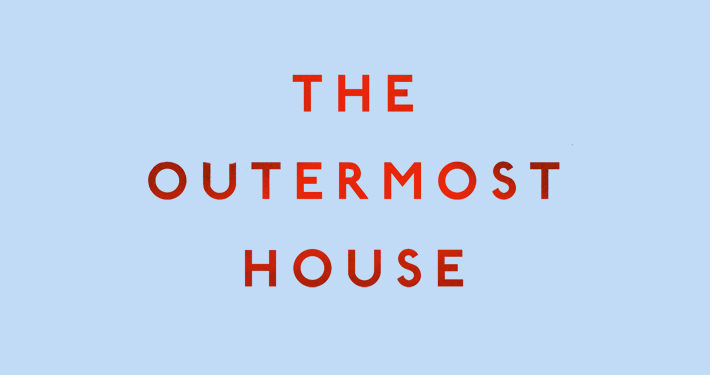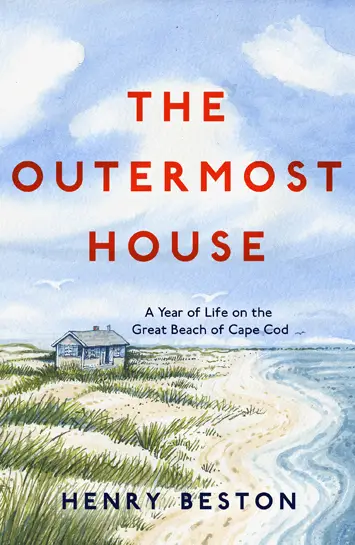The Outermost House by Henry Beston – Review

By Barney Bardsley
In September 1926, a man called Henry Beston visited the tiny summer house he had built, on wild duneland, at the far reaches of Cape Cod, New England, with the intention of staying for two weeks, to soak up the atmosphere of the tempestuous Atlantic coastline. But he was so enchanted, that he ended up living there for an entire year – and he kept a mental record of his experience, which had a profound and lasting effect on his psyche.
Eventually, the memories became this book, The Outermost House. After many years of being out of print in this country, it has now been re-published by Pushkin Press, as part of its international One imprint. And it is a real jewel of a read.
The place that Beston writes about is wild and unpopulated – there is little by way of human contact or interference, except from the jovial coastguards who live further up Cape Cod, and the valiant fishermen who work the nearby ocean. But this suits the author just fine. He soaks up his solitude with relish, and writes about the natural world – the sea, the sand, the great stormy nights, and the quiet mornings – with a real reverence, so that reading his words becomes a kind of meditation, and an immensely soothing experience.
“Formidable powers of description”
 His aim is simple: to watch, with clear-eyed attention, the natural world around him; and to convey his findings as accurately as he can – thereby pulling the reader deeply inside the fierce elemental world that he inhabits. And whilst the language is sometimes arcane – the book is, after all, nearly one hundred years old – his mission is beautifully accomplished. As a piece of nature writing, The Outermost House is both timeless and powerfully relevant. A true classic.
His aim is simple: to watch, with clear-eyed attention, the natural world around him; and to convey his findings as accurately as he can – thereby pulling the reader deeply inside the fierce elemental world that he inhabits. And whilst the language is sometimes arcane – the book is, after all, nearly one hundred years old – his mission is beautifully accomplished. As a piece of nature writing, The Outermost House is both timeless and powerfully relevant. A true classic.
From the opening sentence of the first chapter, “East and ahead of the coast of North America… there stands in the open Atlantic the last fragment of an ancient and vanished land”, the scene is set for a majestic tour through the seasons, and the mercurial moods, of this vast and uninhabited space. Beston does refer to the other human inhabitants around him, the Nauset coastguards, the hapless sailors risking shipwreck in the frequent storms, but it is clear that his real love is for the fauna and flora, for the birds, and for the land and sea itself.
In two particularly fine chapters, ‘The Beach’, and ‘The Headlong Wave’, he uses his formidable powers of description to evoke sand and sea with startling originality: almost as if they were characters in the process of their own creation. “The sand here has a life of its own, even if it is only a life borrowed from the wind…” “The sea has many voices. Listen to the surf, really lend it your ears, and you will hear in it a world of sounds…”
“Startlingly prescient”
As a reader, I have rarely been made more aware by a writer that we are part of a living, breathing, intelligent world – and a very small part, at that. His words, written so long ago, seem startlingly prescient. Caught, as we are, in the middle of political and climate change upheaval, his message seems starkly relevant. He writes, “The world today is sick to its thin blood for lack of elemental things, for fire before the hands, for water welling from the earth, for air, for the dear earth itself underfoot.”
Beston himself had witnessed terrible things, back in the “civilised” world of humans. He had been an ambulance driver on the Western Front in World War One, and was a press representative in the US navy. He saw death and destruction at very close hand. No wonder he found such solace in his little wooden house in the dunes, gazing out at the wind and the weather, and catching a hint of the eternal. For, as he writes, “creation is here and now”, even in the face of catastrophic loss.
His great gift to us is in conveying his sense of wonder and awe at the natural world, so cogently, and with such a poet’s sensibility, in this magical little book. All hail, Pushkin Press, for re-discovering Beston’s work, and for publishing it in such an elegant and handsome edition. Beston’s little house may be long gone (destroyed in a huge winter storm in 1978) but the mark of it remains, indelibly printed, in the pages of this modest little masterpiece.
‘The Outermost House’ by Henry Beston is published by Pushkin Press, £9.99 paperback








